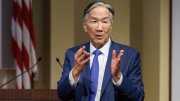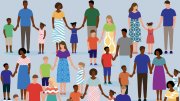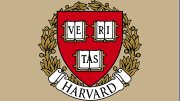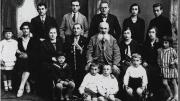“I am an African American,” says Duana Fullwiley, “but in parts of Africa, I am white.” To do fieldwork as a medical anthropologist in Senegal, she says, “I take a plane to France, a seven- to eight-hour ride. My race changes as I cross the Atlantic. There, I say, ‘Je suis noire,’ and they say, ‘Oh, okay—métisse—you are mixed.’ Then I fly another six to seven hours to Senegal, and I am white. In the space of a day, I can change from African American, to métisse, to tubaab [Wolof for “white/European”]. This is not a joke, or something to laugh at, or to take lightly. It is the kind of social recognition that even two-year-olds who can barely speak understand. ‘Tubaab,’ they say when they greet me.”
Is race, then, purely a social construct? The fact that racial categories change from one society to another might suggest it is. But now, says Fullwiley, assistant professor of anthropology and of African and African American studies, genetic methods, with their precision and implied accuracy, are being used in the same way that physical appearance has historically been used: “to build—to literally construct—certain ideas about why race matters.”
Genetic science has revolutionized biology and medicine, and even rewritten our understanding of human history. But the fact that human beings are 99.9 percent identical genetically, as Francis Collins and Craig Venter jointly announced at the White House on June 26, 2000, when the rough draft of the human genome was released, risks being lost, some scholars fear, in an emphasis on human genetic difference. Both in federally funded scientific research and in increasingly popular practice—such as ancestry testing, which often purports to prove or disprove membership in a particular race, group, or tribe—genetic testing has appeared to lend scientific credence to the idea that there is a biological basis for racial categories.
In fact, “There is no genetic basis for race,” says Fullwiley, who has studied the ethical, legal, and social implications of the human genome project with sociologist Troy Duster at UC, Berkeley. She sometimes quotes Richard Lewontin, now professor of biology and Agassiz professor of zoology emeritus, who said much the same thing in 1972, when he discovered that of all human genetic variation (which we now know to be just 0.1 percent of all genetic material), 85 percent occurs within geographically distinct groups, while 15 percent or less occurs between them. The issue today, Fullwiley says, is that many scientists are mining that 15 percent in search of human differences by continent.

Photograph by Stu Rosner
Duana Fullwiley
Last October, Fullwiley and colleagues from 14 academic institutions around the country articulated some of their concerns about ancestry testing in Science magazine. More than half a million people have paid between $100 and $900 for such tests, and for some—those seeking to establish membership in a Native American tribe poised to open a lucrative casino, for example—the stakes can be high. Unfortunately, the Science authors noted, the tests have serious limitations.
Most tests focus on just two types of DNA: the paternally inherited Y sex chromosome that only men carry, and mitochondrial DNA, which is passed exclusively from mothers to their children. Scientists favor these markers with good reason: because only one parent can pass them to offspring, they are not subject to recombination, the reshuffling of genetic data that normally occurs in each generation. But they represent less than 1 percent of a subject’s DNA, and each tells about only one ancestor per generation. Two generations back, a customer might learn about one of four grandparents; three generations back, about one of eight great-grandparents; and by 10 generations back (roughly 250 years ago), such genetic tests reference just one of the 1,024 ancestors in that generation. It doesn’t take long to reach the point when, mathematically, a person’s ancestors start to outnumber the sum total of all people who have ever lived.
Nor can genetic tests verify a person’s race or ethnicity. Genes that affect skin pigmentation or blood proteins involved in malarial resistance, the authors note, may not measure direct and unique ancestry (for example, a founder effect), but reflect instead an evolutionary response to “shared environmental exposures.” Furthermore, the tests are based on comparisons to databases of DNA from living populations, and are therefore vulnerable to “systematic bias” because of “incomplete geographic sampling” or the fact that “present-day patterns of residence are rarely identical to what existed in the past.” One testing company even uses an underlying model that “reinforces the archaic racial view that four discrete ‘parental’ populations (Africans, Europeans, East Asians, and Native Americans) existed in the past” even though “there is little evidence that four biologically discrete groups of humans ever existed….”
Recently, Fullwiley’s concerns have centered on a new kind of genetic testing. For a substantial fee, companies such as 23andMe will “tell you what your propensity is for hypertension, schizophrenia, breast cancer, lactose intolerance, and high or low IQ,” she says. But the studies that have established links between genes and these outcomes are probabilistic, she says, and convey, like ancestry tests, what might be called a false precision. Except for known Mendelian traits or conditions (such as Huntington’s disease) only a fraction of people with a gene variant linked to a disease actually become ill.
Lost in the discussion about genes, she fears, are “epigenetic” influences: factors that affect gene expression but are not part of one’s genetic code, such as prenatal nutrition (which may influence rates of heart disease late in life). Such biosocial factors—environmental, cultural, and economic—can sometimes be more influential than genes. Fullwiley questions, for example, if the prevalence of diabetes among Native Americans on reservations, or of asthma among U.S. Latinos, is only genetic. Her research in Senegal has reinforced that doubt. Scientists have long searched for a genetic difference that would explain why many Senegalese experience a relatively mild form of sickle cell disease. Fullwiley’s work suggests that many of them may instead be mitigating their symptoms with a widespread cultural practice: phytotherapy—the ingestion of roots from a plant that, preliminary studies suggest, triggers production of fetal hemoglobin, a blood-cell type that doesn’t sickle. “When environmental history, or evolutionary history, gets reduced to racial or ethnic difference,” she says, “that’s a big mistake.”
Not all genetics projects are so potentially divisive, however. In February, Spencer Wells, Ph.D. ’94, a former Lewontin student, came to Harvard to tell a story of human connectedness. Wells, who heads the joint National Geographic Society-IBM nonprofit Genographic Project, spent an afternoon with student members of the Harvard Foundation, which represents 72 student organizations “from the Albanian Society to the Vietnamese Society,” says director S. Allen Counter. Wells had previously invited the students to participate in the Genographic Project by sending in cheek swabs with their DNA for analysis. “The idea,” says Counter, “was to show a diverse group of students how they connect to the rest of humanity.”

Photograph by Romana Vysatova 2008 National Geographic
Spencer Wells tells student volunteers of the Harvard Foundation about their deep ancestors' ancient migrations.
Wells has created a human family tree that traces “the journey of man” (as he titled his 2002 book) in populating the entire planet from a homeland in Africa. The project has used linguistic and genetic studies to guide its sampling of indigenous populations from around the globe—many of them isolated and remote—and now has the world’s largest and most representative anthropological database of human DNA.
At Harvard, a Pakistani-American student whose family had always told her they were originally from an area near the Arabian Sea had this confirmed by her DNA result. “Your family was part of the first migration out of Africa,” noted Wells. “You share that with the Australian aborigines.” An African-American student with ancestors from East Africa carried a genetic signature characteristic of that region. But an Asian-American student was surprised to find that she carried almost the same genetic markers as a Mexican-American student. Wells explained, “There is only one change, but you are fairly different because your lines diverged a long time ago. Still, you are part of the same branch of the tree”: the Native Americans who populated the Western Hemisphere originally came from Asia.
The Genographic Project aims to tell people “where their ancestors were living as indigenous people” at different points in time, but can’t, for example, tell most African Americans precisely where in Africa they are from because, Wells explains, “the database isn’t quite there yet.” Echoing Fullwiley’s reservations about all such tests, he says he’s “a bit concerned about some of the African-American DNA testing companies purporting to trace you back to your ancient tribe.” Ancestry is actually more complex for the average African American, he says, not only because people in West Africa (where most of the slave trade occurred) have moved around a lot in the last 500 years, but also because “group composition within Africa has changed over time.” Furthermore, because only a small number of humans survived the journey out of Africa some 50,000 years ago (and the slave trade on that continent was relatively localized), “there is more diversity in the average African village,” Wells notes, “than there is outside of Africa combined.”
When asked about the question of race, Wells’s answer was unequivocal. “Racism is not only socially divisive, but also scientifically incorrect. We are all descendants of people who lived in Africa recently,” he says. “We are all Africans under the skin.” The kinds of differences that people notice, such as skin pigmentation, limb length, or other adaptations are “basically surface features that have been selected for in the environment. When you peer beneath the surface at the underlying level of genetic variation, we are all much more similar than we appear to be. There are no clear, sharp delineations.”
The Human Family Tree

Map copyright © 2005 National Geographic Society
The movements of particular genetic markers—those from the male Y chromosome in blue, and those from maternally inherited mitochondrial DNA in orange—have been plotted on a map by the National Geographic Society-IBM Genographic Project to show the routes humans took as they moved out from an ancestral homeland in East Africa to populate the entire planet. For more information, visit www.nationalgeographic.com/genographic
Fullwiley’s own ethnographic research among genetic scientists suggests that much of current medical genetics may reinforce ideas of racial difference. Because certain diseases occur at higher frequencies in some populations (sickle cell anemia in blacks, Tay-Sachs disease in Jews of eastern European ancestry), they have become linked to the idea of race, even when the disease does not result from common ancestry. Sickle cell trait, for example, has arisen independently in several populations as an evolutionary response to malaria. The genetic change appeared first in India and then in Africa; it is also found in Greeks and Italians. But in the United States, Fullwiley says, sickle cell trait is very much linked to African-American racial identity through the history of medicine.
She says the potential for racialization of medical genetics has been institutionalized because “you can’t get a grant from the NIH unless you recruit in racial groups, label people by census category, and then report back the data in terms of outcomes by racial type.” The original intent—to counter the widespread use of the white male body as the working research norm—is “fine and good,” she says, but there “ought to be some flexibility to these race categories, and some thinking about what they mean. This new construction of race…is socially inflected—but it is not solely a social construct because biology is front and center.”








